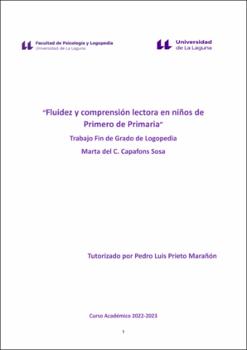Fluidez y comprensión lectora en niños de primero de Primaria
Fecha
2023Resumen
Esta investigación tiene como objetivo comprobar si un grupo de alumnos nombrado
como grupo experimental, consigue mejorar en los aspectos de fluidez y comprensión
lectora (en base a un programa breve de lectura hacia arriba) en comparación con otro
grupo nombrado como grupo control, que ha estado leyendo de manera habitual, es decir,
como le han enseñando en su aula.
La hipótesis que se propone es que los alumnos que pertenecen al grupo
experimental que han estado leyendo con este método que consiste en tapar la parte de
abajo de las frases mientras leen, acceden primero a la parte de arriba de los fonemas,
haciendo un reconocimiento más rápido de las palabras consiguiendo un proceso lector
más fluido.
Los resultados indican que no hay diferencias significativas ni en la fluidez ni en la
comprensión entre el grupo control y el grupo experimental. Ambos grupos mejoran en el
post-test tanto en la fluidez lectora como en las respuestas sobre la comprensión de los
textos. Las no diferencias encontradas entre ambos grupos pueden ser debidas al escaso
número de sesiones de entrenamiento del grupo experimental, ya que, tanto este grupo
como el control utilizaban el mismo sistema de aprendizaje y de entrenamiento de la lectura
la mayor parte del tiempo (en el centro escolar, en casa, etc…) The aim of this study is to verify if a group of students, labeled as an experimental
group, manages to improve in both, fluency and reading comprehension (based on a brief
upward reading program) in comparison with another group labeled as control group, which
has been reading regularly, that is, as they have been taught in their classroom.
The hypothesis proposed is that the students who belong to the experimental group,
who have been reading with this method that consists of covering the bottom part of the
sentences while reading, first access the top part of the phonemes, achieving to recognise
the words in a significantly lower time, making the reading task more fluid.
The results indicate that there are no significant differences in fluency or
comprehension between the control group and the experimental group. Both groups improve
in the post-test both in reading fluency and in the answers about the comprehension of the
texts. The non-differences found between the two groups may be due to the low number of
training sessions in the experimental group, since both this group and the control used the
same learning and reading training system most of the time (in the school, at home, etc...).





